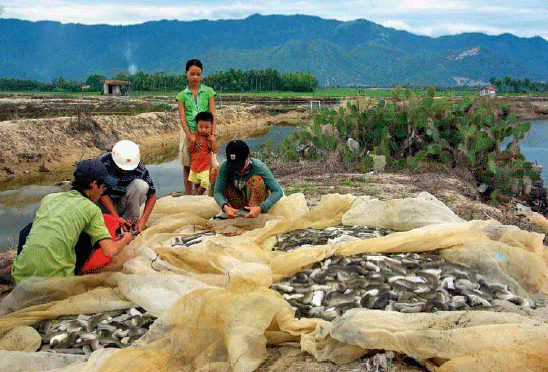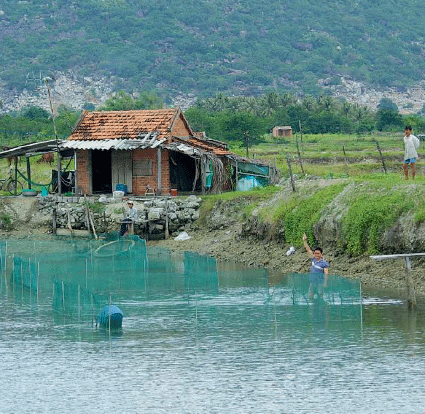Sea cucumbers are highly regarded in China for their medicinal properties, including as an aphrodisiac, and demand for the product is almost insatiable. While wild stocks of sea cucumbers are diminishing, there is growing excitement about the prospect of commercially cultivating one of the most desirable tropical species, Holothuria scabra, also known as sandfish.
Close to 100 researchers, government and community development representatives gathered for the Asia–Pacific Tropical Sea Cucumber Aquaculture Symposium in New Caledonia in February to share information about the state of sandfish aquaculture research and development.
The symposium was jointly sponsored by ACIAR and the Secretariat for the Pacific Community. Attendees came from Central America, Madagascar, Tanzania, Maldives, India, Vietnam, the Philippines, Papua New Guinea, Australia, Japan, China and various Pacific nations.
ACIAR and the WorldFish Center have been investing in sea cucumber cultivation research in Vietnam, the Philippines, Solomon Islands, New Caledonia, Fiji and Australia since the mid 1990s. Current projects are focused on hatchery culture, techniques for releasing sandfish into the wild, and sea ranching and pond culture. These projects are based in the Philippines, Vietnam and northern Australia.
ACIAR’s Fisheries research program manager Dr Chris Barlow says the aim of the symposium was to discuss the status of research and future directions, and to harmonise research efforts. This is especially important given that interest in sandfish cultivation is strong right across the tropical region, from East Africa through the Pacific region to Central America.
“All sea cucumbers have different qualities, just like fish—different texture, colour, flavour, size and eating qualities,” Dr Barlow says. “Holothuria scabra happens to be the most sought after of the tropical species.”
Cultivation of H. scabra is not as straightforward as other temperate species of sea cucumber, which are more amenable to aquaculture and already widely cultivated commercially in Japan and China. But Dr Barlow says there was good exchange of information during the symposium, which was somewhat facilitated by the fact that most of the research is still in the pre-commercial phase.
Among the speakers at the symposium was Professor Annette Meñez from the University of the Philippines Marine Science Institute (UPMSI). The Philippines is the second-largest exporter of sea cucumber products but the resource has been overfished and unmanaged.
Professor Meñez has pioneered communitybased sea ranching as a cultivation strategy that can help local fishers supplement their income and help rebuild wild sea cucumber populations. Sea ranching involves stocking hatchery-reared juvenile sandfish into wild marine habitats to grow out.
She leads the ACIAR sandfish research project in the Philippines that was responsible for establishing three 5 hectare trial sites at Anda, Masinloc and Victory. A critical aspect of the project is liaison between local government authorities and community partners to establish exclusive harvesting rights for communities participating in sea-ranch trials. She also oversees juvenile production in the hatchery and monitoring of released juveniles in the field.
ACIAR’s sea cucumber sea-ranching project in the Philippines is part of a broader national research program to improve the management of sea cucumber fisheries and develop a sustainable industry. The national program is supported by the Department of Science and Technology and the Department of Agriculture’s Bureau of Agricultural Research.
Professor Meñez says increasing juvenile production to supply the sea-ranching project has been difficult because of limited hatchery space at the UPMSI laboratory and lack of access to suitable ponds for juvenile rearing. In response, she and her team have developed ocean nursery systems to culture juveniles to a release size.

They have been able to demonstrate that viable spawning populations can be established in sea-ranching areas. This technique can also be used to help rebuild depleted stocks, as larvae settle in the ranching sites and adjacent areas.
Professor Meñez says poaching from the sea ranches has been an ongoing issue. Sharing information, consultation with adjacent villages and regular guarding of the sea-ranched areas have helped to reduce poaching in some villages. Guarding is undertaken 24 hours a day, seven days a week, although it has been difficult for some community partners to maintain the commitment required to do this for the 12 months or more it takes sandfish to reach harvestable size.
Natural disturbances, particularly typhoons, have also reduced harvestable yields at the trial sites. At the Victory site the sandfish biomass almost halved following a succession of typhoons that changed sediment quality and reduced the area of suitable substrate for feeding in the seagrass beds.
“We cannot do anything about this but we can learn much from the results to improve future efforts,” Professor Meñez says. “This might include better site selection or changes to the timing of release of juveniles.”
She says in addition to supplementary income from sandfish harvesting, the participating communities have benefited from new knowledge and skills, the opportunity to share what has been learned, and the use of sea ranching to improve the management of fisheries for future generations.
“The commitment of our community participants has varied, but we have a core group of very active partners. Perception surveys we conducted after 3 years indicate that, despite the challenges, the majority are willing to continue with the sea ranching. They would like to see it institutionalised by their local government body, even when the project ends.”
Research based in Vietnam is focused on pond aquaculture, using ponds previously used for shrimp farming. Dr David Mills of the WorldFish Center oversees the ACIAR sea cucumber research. He says the Vietnam research has simplified hatchery and breeding techniques, making the breeding system more easily adopted in developing countries.
This research is ongoing at the National Seed Production Center of the Research Institute for Aquaculture No.3 at Van Ninh, in Vietnam’s central coastal region.
“The aim is to ensure all levels of sea cucumber cultivation can be undertaken at a community level, maximising the benefit to communities,” Dr Mills says. “Key achievements have been the adoption of simple algal paste coatings to promote settlement of larvae on plastic plates, and a refinement of algae food sources for the larvae and juvenile sea cucumbers.”
Research is also continuing to evaluate the benefits of sea cucumbers as an alternative to shrimp and when grown in rotation with shrimp. Dr Mills says sea cucumbers actually clean the ponds, which can become sludgy and toxic if used consistently for shrimp production.
“They have a positive environmental benefit,” he says. “Disease can also cause two out of three shrimp crops to be lost, but growing alternate crops of shrimp and sea cucumbers may be able to help reduce the disease risk.”
Both benefits have the potential to extend the lifespan of ponds, which are otherwise rebuilt every 10 years or so. This is important because often sensitive coastal habitats, including mangrove areas, are cleared for the construction of new ponds.
Dr Mills says one of the key issues to emerge from the symposium was the need for an assessment of genetic risk. Some sea cucumber fisheries have been almost entirely fished out and non-indigenous brood-stock is being imported into these areas.

Chemically induced spawning, while effective, also has the potential to reduce genetic diversity. He says work in the Philippines has the most precautionary approach, with brood-stock not only endemic to the country, but locally native—taken from within 50 kilometres of the sea-ranched sites where the juveniles are to be raised.
ACIAR has two smaller sea cucumber projects within the larger Pacific Agricultural Research and Development Initiative that complement the aquaculture research and development. One is evaluating the whole value chain for sea cucumbers. The other is developing training and processing, handling and marketing skills to produce more consistent and higher-grade sandfish products, known variously as bêchede- mer, trepang or balate.
ACIAR is also supporting research at the Darwin Aquaculture Centre to improve the release methods for juvenile sandfish into sea ranches. Tasmanian Seafoods is an industry partner in this project, holding all commercial sea cucumber harvesting licences in the Northern Territory.
Productivity of wild-caught sea cucumbers along Australia’s northern coast is estimated to have declined to less than 10% of precolonial yields. Sea ranching provides an opportunity to rebuild the fishery population. Tasmanian Seafoods research manager Grant Leeworthy says ACIAR sea cucumber projects in Solomon Islands provided a guide for further research, which the company has undertaken independently to enhance local stocks and improve processing.
Tasmanian Seafoods assists with some of the logistical requirements of the research. “We see the ACIAR project as a tool to help build relationships with researchers and with local Indigenous communities,” he says.
Mr Leeworthy says the company is working with Indigenous communities to develop employment opportunities and joint ventures managing sea ranches and harvesting sea cucumbers. Tasmanian Seafoods has already established agreements with the Umbakumba community on Groote Eylandt and the Northern Territory Fisheries Department to assist with sea ranching and the re-establishment of the sea cucumber fishery.
March 2012


